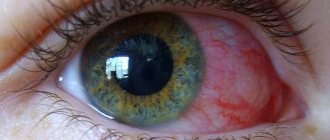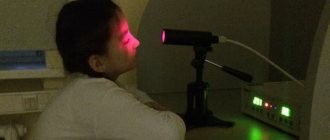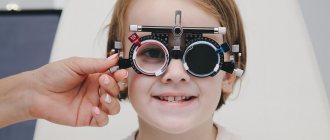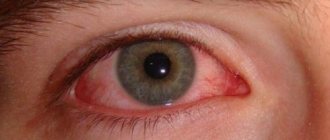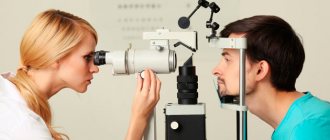Anisocoria is a symptom in which the pupils are different sizes. This condition is caused by the fact that one eye reacts correctly to light stimuli (the pupil narrows in bright light and dilates in insufficient light), while the other remains in a fixed position.
Anisocoria can be of several types:
- Congenital. It is observed in children with an incompletely formed nervous system or brain or disorders in embryonic development. Pupils of different sizes in a child are considered a pathology, however, as a rule, they do not in any way affect the quality of life. Over time, the defect may disappear.
- Physiological. This is the name given to the natural state when the pupils at rest differ in diameter by no more than 1 mm. In this case, it is enough to drop drops that dilate the pupil so that both eyes become symmetrical again.
- Pathological. The symptom develops against the background of ophthalmological or neurological disorders. Diagnosis and treatment are necessary.
Why can pupils be different sizes?
The pupil is an opening in the iris through which light enters the eye. Its size is regulated reflexively depending on the brightness of the lighting (the darker the room, the wider it is), emotional state, pain, as well as under the influence of certain medications and drugs. In bright light, the diameter of the pupils is from 2 to 4 mm, in the dark it reaches 8 mm.
The muscles of the iris, which receive signals from the oculomotor nerve, are responsible for the dilation (mydriasis) and narrowing (miosis) of the pupil. If a person is healthy, then the pupils react to stimuli synchronously. The increase in diameter is provided by the dilator, controlled by the sympathetic autonomic nervous system, and the decrease by the sphincter, controlled by the parasympathetic nervous system.
The reasons for different pupil sizes are associated with disorders of the muscles and nerves. For example, if compression of the nerves in the neck occurs, this can lead to physiological anisocoria. As a rule, this condition does not pose a danger and indicates the need for a visit to a neurologist or traumatologist. However, there are also serious diseases, the symptom of which is an uneven diameter of the holes in the iris. The most common are:
- Horner's syndrome. This is a disorder of the sympathetic nervous system, which is caused by pathology in the chest or neck area. Horner's syndrome can occur due to tumors, injuries to the cervical or thoracic spine, inflammation of the nervous system, and other factors.
- Adi's syndrome. It is a neurological disorder caused by damage to postganglionic fibers by a viral or bacterial infection.
- Disorders of the oculomotor nerve. Anisocoria can be caused by trauma, neuroinfectious diseases, diabetes mellitus, stroke, etc.
- Damage to the muscles of the iris. Pathology can occur due to surgery, trauma, and inflammatory processes. In particular, the cause of pupils of different sizes in an adult or child can be iritis, an inflammation of the iris.
- Injuries, swelling, concussion. Bleeding in the brain causes compression of the nerves that control the dilation and constriction of the pupil. If bleeding affects one side of the brain, the pupils become different diameters.
- Some pathologies of internal organs (Roke's syndrome, diseases of the abdominal organs).
- Multiple sclerosis.
Drugs can also be the reason why an adult's pupils are different sizes. Depending on the type of substance - stimulant or sedative - the nervous system is depressed or stimulated. In both cases, spasm of the optic nerve is possible. The pupil loses mobility and freezes in one place. A similar reaction is observed when taking certain medications.
Anisocoria in infants most often occurs when the cervical spine is damaged as a result of birth trauma. Pinched nerves lead to the child having different pupils. Other causes include structural abnormalities of the eyes (for example, idiopathic microcoria), oculomotor nerve palsy, and Horner's syndrome.
What is anisocoria?
Simply put, anisocoria is a difference in the size of the pupils of the right and left eyes. One pupil may be larger than normal or smaller than normal. This results in different pupil sizes. In general, the reaction of the two pupils to light may or may not be normal.
In most cases, anisocoria is a benign condition, so there is no cause for concern. However, if your pupils suddenly become different sizes, you have a rare type of anisocoria that may be a symptom of a serious medical condition.
Diagnosis of anisocoria
Since different pupils can be a symptom of a large number of diseases, a careful history is required to look for concomitant pathologies. To do this, ophthalmologists use the following examinations:
- slit lamp examination.
- retinoscopy;
- diaphanoscopy;
- biomicroscopic examination;
- iris sensitivity test for M-cholinomimetics.
Additionally, for anisocoria, MRI, CT, contrast angiography, ultrasound, and general blood test are prescribed.
Diagnosis and treatment of different pupils
Treatment for anisocoria can be selected only after determining the cause that caused it. When you contact our clinic, you will receive a comprehensive eye examination, consultation with an ophthalmologist, and a prescription for treatment. However, be prepared that your doctor may also refer you for a brain scan, X-ray, MRI, or blood test. This is necessary in order to exclude a number of diseases.
If after all examinations the disease is not detected, as a rule, anisocoria is recognized as an individual hereditary feature that does not require treatment. We are waiting for you at the Eye Clinic of Dr. Belikova.
How to distinguish between physiological and pathological anisocoria
This is an important problem, since pupils of different sizes are a symptom of serious diseases. You should definitely consult a doctor if anisocoria is accompanied by:
- pain in the eyes;
- red eyes or swollen eyelids;
- protrusion of the eyeball forward;
- excessive tearing;
- headache and dizziness;
- distortion of images, decreased visual acuity, impaired spatial perception, the appearance of circles or spots before the eyes;
- nausea, vomiting;
- confusion;
- problems with body control, hand tremors.
Classification of pathology and its causes
There are several main causes of anisocoria, which involve dozens of different diseases and conditions. In 20% of cases, anisocoria in infants is a consequence of a genetic defect. The child most often does not have any other symptoms, and the pathology of the pupil does not exceed 0.5-1 mm. In such cases, anisocoria may disappear by 5-6 years.
Types of anisocoria
- Congenital. This type of pathology is often the result of a defect in the eye or its individual elements. The reason affects the muscular apparatus of the iris and causes asynchrony in the reaction of the pupils to light. It happens that congenital anisocoria is a symptom of underdevelopment of the nervous apparatus of one eye or both, but in almost all cases the pathology is complemented by strabismus.
- Acquired. There are many reasons that can cause anisocoria throughout life.
One of the most common causes of pupillary mismatch is injury. There are several types of injuries that can cause anisocoria. First of all, these are eye injuries. Often the synchrony of pupil reactions is disrupted due to damage to the iris or ligamentous apparatus of the eye. With an eye contusion, when there are no visible injuries, paralysis of the muscular structure of the iris may develop, and the pressure inside the eye will increase.
When a head injury occurs, there is always a risk of injury to the skull or brain. Anisocoria may be the result of impaired functionality of the nervous system of the eyes or visual centers in the cerebral cortex. When the visual centers are damaged, strabismus often develops. Disturbance in the functioning of the optic nerves often leads only to one-sided dilation of the pupil. Distinctive feature: the pupil dilates in the eye on the side of the injury.
Eye diseases also often manifest themselves through anisocoria. Such ophthalmological disorders can be inflammatory or non-inflammatory in nature. Iritis and iridocyclitis (isolated inflammation of the iris) can cause spasms of the iris muscles. As a result, the eye stops responding to changes in light, which is expressed by mismatch of the pupils. Glaucoma often provokes a narrowing of the pupil in the affected eye (permanent): this makes the outflow of intraocular fluid faster and easier.
The growth of neoplasms and tumors in the head leads to a weakening of the connection between the eyeballs and the visual centers. As a result, the functionality of the iris is impaired. Such pathologies include malignant brain tumors, neurosyphilis, and hematomas in the brain after a hemorrhagic stroke.
Anisocoria can occur when exposed to certain inorganic substances: belladonna, atropine, tropicamide. When these compounds affect the nerves and muscles of the eye, pupil misalignment may occur.
Diseases of the brain and visual nerve pathways are also at risk. Among the main diseases of the central nervous system that can cause anisocoria are neurosyphilis and tick-borne encephalitis, meningitis and meningoencephalitis.
Types of anisocoria
- Caused by eye pathologies. The condition occurs due to disturbances in the elements of the eye.
- Caused by other pathologies.
According to the degree of involvement, unilateral and bilateral anisocoria are distinguished. In 99% of cases, a unilateral eye pathology is diagnosed, that is, one normal eye reacts to changes in light, and the pupil of the second either does not react or functions late.
Bilateral anisocoria is a fairly rare occurrence. The condition is characterized by an uncoordinated and inadequate response of the iris to changes in the visual regime. The degree of pathology may be different for each eye.
Is it necessary to treat anisocoria?
Anisocoria is only a symptom: first you need to find out why the pupils are different, and then begin to treat this disease. For example, if miosis is caused by iritis, anti-inflammatory and antibacterial agents are prescribed. If the patient has Horner's syndrome, neurostimulation with low-amplitude electrical impulses is prescribed and, if the disease occurs due to a hormonal imbalance, hormone replacement therapy. In case of mechanical damage to the eyes, the foreign body is removed, atropine or pilocarpine is instilled, autohemotherapy and antibiotics are prescribed. For Adi syndrome, pilocarpine is prescribed.
Diagnosis of the causes of pupillary defect
The first stage in diagnosing the causes of anisocoria is collecting an anamnesis. The doctor must identify all concomitant pathologies, study their causes, development and duration. Photographs of the patient help in diagnosing anisocoria. From them you can find out whether the pathology existed before and with what dynamics it developed.
During an eye examination, the doctor determines the size of the pupils in light and in the dark, reaction speed, and consistency under different lighting conditions. These simple characteristics help to at least approximately determine the cause of anisocoria and the localization of the disorder that provokes pupil mismatch.
Anisocoria, which is more pronounced in bright light, is indicated by pathology when the pupil dilates to a large size and has difficulty constricting. With anisocoria, which is more pronounced in a dark environment, the pupil becomes unnaturally small and dilates with difficulty.
Methods for diagnosing anisocoria
- Cocaine test. In the process, a 5% solution of cocaine is used (if the patient is a child, a 2.5% solution is used). Sometimes the cocaine solution is replaced with apraclonidine 0.5-1%. The test allows you to differentiate physiological anisocoria from Horner's syndrome. The procedure is simple: drops are dropped into the eyes and the size of the pupils is assessed before the procedure and after 60 minutes. If there are no pathologies, the pupils gradually dilate. In the presence of Horner's syndrome, the pupils on the affected side dilate to 1.5 mm.
- Phenylephrine and tropicamide tests. A solution of 1% tropicamide or phenylephrine can detect a defect in the third neuron of the sympathetic system, although a defect in the first and second cannot be excluded. The procedure is as follows: drops are instilled into the eye, analyzing the size of the pupils before and after the procedure (after 45 minutes). An expansion of less than 0.5 mm will indicate pathology. With an increase in anisocoria by 1.2 mm, we can talk about damage with a probability of 90%.
- Pilocarpine test. For the procedure, a 0.125-0.0625% solution of pilocarpine is used. The defective pupils are sensitive to the product, while healthy eyes do not react to it. Pupil dilation should be assessed half an hour after instillation.
Anisocoria may be associated with these symptoms
- Pain. May indicate expansion or rupture of an intracranial aneurysm, which is dangerous due to compression paralysis of the third pair of oculomotor nerves. Pain also appears during dissection of the carotid artery aneurysm. Another cause of pain may be microvascular oculomotor neuropathy.
- Double vision.
- Ptosis and diplopia. May indicate damage to the third pair of oculomotor nerves (cranial).
- Proptosis (protrusion of the eyeball forward). Often accompanied by space-occupying lesions of the orbit.
If vascular abnormalities are suspected, contrast angiography and Doppler ultrasound are prescribed. Diagnosis of ocular dysfunction often includes CT, MRI and MSCT with vascular contrast. Even if there are no other symptoms, these tests can detect aneurysm and brain tumor - the most common causes of anisocoria. Neuroimaging studies allow us to determine the exact treatment plan and the need for neurosurgery.
Treatment of anisocoria
For anisocoria that is not caused by pathology of the iris, treatment should be aimed at eliminating the underlying disease. Pupillary mismatch will disappear on its own after successful therapy.
If the cause lies in an inflammatory disease of the brain (meningitis, meningoencephalitis), broad-spectrum antimicrobial agents, detoxification therapy, and measures to correct the water-salt balance are needed.
In case of head injuries, you need to act quickly: lack of synchrony in the pupils is a bad symptom. Surgery to the skull is often required to eliminate the dangerous consequences of the injury.
If pupil misalignment is caused by injury or disease of the eye, therapy is more clear-cut. It is necessary to eliminate the pathology and correct the muscle activity of the iris. The doctor prescribes medications that directly affect the processes of dilation and constriction of the pupils. For iritis and iridocyclitis, anticholinergic drugs are needed that relax the muscles of the iris. Long-term use of such drugs can lead to permanent dilation of the pupils. Ophthalmologists also prescribe medications to eliminate inflammation.
With congenital anisocoria, the question of treatment will depend on the degree of the disorder. Most often, several operations are required to correct the eye defect. It is rare, but it happens that surgery is impossible (0.01% of all cases of congenital anisocoria). In this case, patients are prescribed eye drops for life.
Sources used:
- Morozov, V.I. Pharmacotherapy of eye diseases / V.I. Morozov, A.A. Yakovlev. - M.: Medicine, 2004.
- Rational pharmacotherapy in ophthalmology. - M.: Litterra, 2011.
- D. Hubel. Eye, brain, vision. — ed. A. L. Byzova. - M.: Mir, 1990.
- E. Fuchs Textbook of eye diseases. Volume I / E. Fuchs. — M.: State Publishing House of Medical Literature, 2021.
- Wikipedia article




